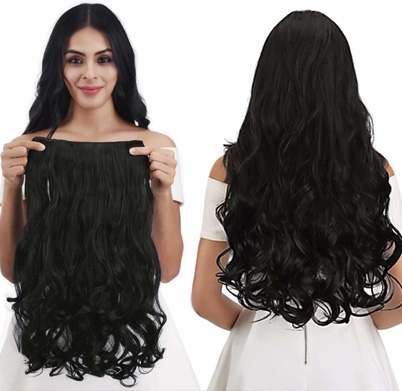Hair extensions are artificial hairpieces that are used to add length, volume, and sometimes color to a person's natural hair. They are a popular cosmetic accessory and can be worn for various reasons, including fashion, special occasions, or to address issues such as hair thinning or short hair. Here's an overview of hair extensions:
Types of Hair Extensions:
- Clip-In Extensions: These are temporary extensions that are attached to the natural hair with small clips or combs. Clip-in extensions are easy to apply and remove and are commonly used for special occasions or to add volume and length for a short period.
- Tape-In Extensions: Tape-in extensions are semi-permanent and are typically attached using double-sided adhesive tape. They can last several weeks and are less damaging to the natural hair than some other methods.
- Sew-In or Weave Extensions: These are attached by braiding the natural hair into cornrows and then sewing the extensions into the braids. Sew-in extensions can last for several weeks and provide a secure hold.
- Micro-Link or Micro-Bead Extensions: These extensions are applied using tiny metal or silicone beads that are clamped onto the natural hair strands, holding the extensions in place. They are semi-permanent and can be adjusted as the natural hair grows.
- Fusion or Keratin Bond Extensions: Fusion extensions involve attaching individual strands of extensions to the natural hair using a heated keratin adhesive. They can last for several months but may require more maintenance.
- Clip-On Ponytails and Bangs: These are extensions designed to create specific hairstyles, such as ponytails or bangs. They are typically attached using clips and provide a quick transformation.
Benefits of Hair Extensions:
- Length and Volume: Hair extensions are an effective way to add length and volume to the natural hair, allowing individuals to achieve various hairstyles.
- Versatility: Hair extensions come in a wide range of colors, textures, and lengths, allowing for creativity and the ability to change one's look easily.
- Non-Permanent: Many types of hair extensions are non-permanent and can be worn as desired, making them suitable for special occasions or temporary style changes.
- Hair Color Experimentation: Extensions can be used to experiment with different hair colors without the need for dyeing the natural hair.
- Concealing Hair Issues: Extensions can be used to conceal hair thinning, bald spots, or other hair-related concerns.
Considerations:
- Maintenance: Hair extensions require regular maintenance, including washing, conditioning, and brushing. The level of care may vary depending on the type of extensions used.
- Cost: The cost of hair extensions can vary significantly depending on the type of extensions, the quality of the hair, and the application method. High-quality human hair extensions tend to be more expensive.
- Potential Damage: Improper installation or removal of extensions can lead to damage to the natural hair, such as breakage or thinning. It's crucial to have extensions applied and removed by a trained professional.
- Allergies and Sensitivities: Some individuals may have sensitivities to the materials used in hair extensions, such as adhesives or metals. A patch test or consultation with a hairstylist can help identify any potential issues.
- Comfort: Extensions can feel heavy or uncomfortable, especially if not applied correctly. It may take some time to adjust to wearing them.


